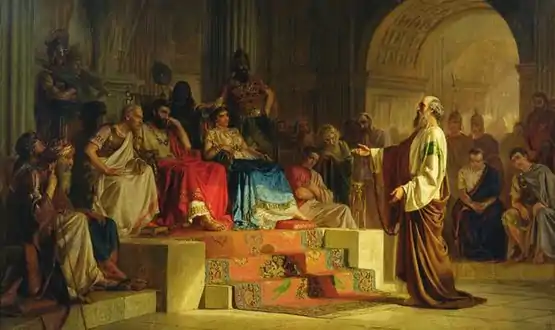Herod Agrippa II
Herod Agrippa II (Hebrew: אגריפס; AD 27/28[1] – c. 92 or 100[1][2]), officially named Marcus Julius Agrippa and sometimes shortened to Agrippa, was the last ruler from the Herodian dynasty, reigning over territories outside of Judea as a Roman client. Agrippa II fled Jerusalem in 66, fearing the Jewish uprising and supported the Roman side in the First Jewish–Roman War.
| Herod Agrippa II | |||||
|---|---|---|---|---|---|
| king in parts of Judea | |||||
 | |||||
| Born | 27/28 AD | ||||
| Died | c. 92 or 100 | ||||
| |||||
| Dynasty | Herodian dynasty | ||||
| Father | Herod Agrippa I | ||||
| Mother | Cypros | ||||
Early life
Herod Agrippa II was the son of the first and better-known Herod Agrippa and the brother of Berenice, Mariamne, and Drusilla (second wife of the Roman procurator Antonius Felix).[3] He was educated at the court of the emperor Claudius, and at the time of his father's death he was only seventeen years old. Claudius therefore kept him at Rome, and sent Cuspius Fadus as procurator of the Roman province of Judaea. While at Rome, he voiced his support for the Jews to Claudius, and against the Samaritans and the procurator of Iudaea Province, Ventidius Cumanus, who was lately thought to have been the cause of some disturbances there.[1]
Rise in power
On the death of king Herod of Chalcis in 48, his small Syrian realm of Chalcis was given to Agrippa, with the right of superintending the Temple in Jerusalem and appointing its high priest, but only as a tetrarch.[4][5]
In 53, Agrippa was forced to give up the tetrarchy of Chalcis but in exchange Claudius made him ruler with the title of king over the territories previously governed by Philip, namely, Iturea, Trachonitis, Batanea, Gaulanitis, Auranitis and Paneas, as well as the kingdom of Lysanias in Abila.[6][7][8] The tetrarchy of Chalcis was subsequently in 57 given to his cousin, Aristobulus (Acts 25:13; 26:2,7). Herod Agrippa celebrated by marrying off his two sisters Mariamne and Drusilla. Flavius Josephus, the Jewish historian, repeats the gossip that Agrippa lived in an incestuous relationship with his sister, Berenice.
In 55, the Emperor Nero added to Agrippa's realm the cities of Tiberias and Taricheae in Galilee, and Livias (Iulias), with fourteen villages near it, in Peraea.

It was before Agrippa and his sister Berenice that, according to the New Testament, Paul the Apostle pleaded his case at Caesarea Maritima, probably in 59 or 60 (Acts 26).
Agrippa expended large sums in beautifying Jerusalem and other cities, especially Berytus (ancient Beirut), a Hellenised city in Phoenicia. His partiality for the latter rendered him unpopular amongst his own subjects, and the capricious manner in which he appointed and deposed the high priests made him disliked by his coreligionists.
During the Jewish–Roman War
In the seventeenth year of Agrippa's reign (corresponding with the 12th year of Nero's reign, or 65/66 AD), Agrippa tried desperately to avert a war with Rome,[9] when he saw his countrymen generally disposed to fight against Rome, because of certain insults and abuses they had been facing under the Roman procurator, Gessius Florus. At this time, they had broken off the cloisters leading from Antonia Fortress to the Temple Mount where Roman soldiers went to keep guard during the Jewish holidays, and they refused to pay the due tribute to Rome.[10] Agrippa convened the people and urged them to tolerate the temporary injustices done to them and submit themselves to Roman hegemony. At length, Agrippa failed to prevent his subjects from rebelling, whereas, during a certain holiday when the Roman governor of Syria, Cestius Gallus, had passed through Judea to quell the rebellion, he was routed by Jewish forces.[11] By 66 the citizenry of Jerusalem expelled their king, Agrippa, and his sister, Berenice, from Jerusalem.[1] During the First Jewish–Roman War of 66–73, he sent 2,000 men, archers and cavalry, to support Roman general Vespasian, showing that, although a Jew, he was entirely devoted to the Roman Empire.[2] He accompanied Vespasian's son Titus on part of his campaigns against the rebels,[1] and was wounded at the siege of Gamla. After the capture of Jerusalem, he went with his sister Berenice to Rome, where he was invested with the dignity of praetor and rewarded with additional territory.
Death
According to the patriarch Photius I of Constantinople, Agrippa died childless at the age of seventy, in the third year of the reign of Trajan, that is, 100,[15] but statements of historian Josephus, in addition to the contemporary epigraphy from his kingdom, cast this date into serious doubt. The modern scholarly consensus holds that he died before 93/94.[1] He was the last ruler from the House of Herod.
Ancestry
| Ancestors of Herod Agrippa II | ||||||||||||||||||||||||||||||||||||||||||||||||||||||||||||||||||||||||||||||||||||||||||||||||||||||||||||||||||||||||||||||||||||||||||||||||||||||||||||||||||||||||||||||||||||||||||||||||||||||||||||||||||||||||||||||||||||||||||||||||||||||||||||||||||||||||||||||||||||||||||||||||||||||||||||||||||||||||||||||||||||||||||||||||||||||||||||||||||||||||||||||||||||||||||||||||||||||||||||||||||||||||||||||||||||||||||||||||||||||||||||||||||||||||||||||||||||||||||||||||||||||||||||||||||||||||||||||||||||||||||||||||||||||||||||||||||||||||||||||||||||||||||||||||||||||||||||||||
|---|---|---|---|---|---|---|---|---|---|---|---|---|---|---|---|---|---|---|---|---|---|---|---|---|---|---|---|---|---|---|---|---|---|---|---|---|---|---|---|---|---|---|---|---|---|---|---|---|---|---|---|---|---|---|---|---|---|---|---|---|---|---|---|---|---|---|---|---|---|---|---|---|---|---|---|---|---|---|---|---|---|---|---|---|---|---|---|---|---|---|---|---|---|---|---|---|---|---|---|---|---|---|---|---|---|---|---|---|---|---|---|---|---|---|---|---|---|---|---|---|---|---|---|---|---|---|---|---|---|---|---|---|---|---|---|---|---|---|---|---|---|---|---|---|---|---|---|---|---|---|---|---|---|---|---|---|---|---|---|---|---|---|---|---|---|---|---|---|---|---|---|---|---|---|---|---|---|---|---|---|---|---|---|---|---|---|---|---|---|---|---|---|---|---|---|---|---|---|---|---|---|---|---|---|---|---|---|---|---|---|---|---|---|---|---|---|---|---|---|---|---|---|---|---|---|---|---|---|---|---|---|---|---|---|---|---|---|---|---|---|---|---|---|---|---|---|---|---|---|---|---|---|---|---|---|---|---|---|---|---|---|---|---|---|---|---|---|---|---|---|---|---|---|---|---|---|---|---|---|---|---|---|---|---|---|---|---|---|---|---|---|---|---|---|---|---|---|---|---|---|---|---|---|---|---|---|---|---|---|---|---|---|---|---|---|---|---|---|---|---|---|---|---|---|---|---|---|---|---|---|---|---|---|---|---|---|---|---|---|---|---|---|---|---|---|---|---|---|---|---|---|---|---|---|---|---|---|---|---|---|---|---|---|---|---|---|---|---|---|---|---|---|---|---|---|---|---|---|---|---|---|---|---|---|---|---|---|---|---|---|---|---|---|---|---|---|---|---|---|---|---|---|---|---|---|---|---|---|---|---|---|---|---|---|---|---|---|---|---|---|---|---|---|---|---|---|---|---|---|---|---|---|---|---|---|---|---|---|---|---|---|---|---|---|---|---|---|---|---|---|---|---|---|---|---|---|---|---|---|---|---|---|---|---|---|---|---|---|---|---|---|---|---|---|---|---|---|---|---|---|---|---|---|---|---|---|---|---|---|---|---|---|---|---|---|---|---|---|---|---|---|---|---|---|---|---|---|---|---|---|---|---|---|---|---|---|---|---|---|---|---|---|---|---|---|---|---|---|---|---|---|---|---|---|---|---|---|---|---|---|---|---|---|---|---|---|---|---|---|---|---|---|---|---|---|---|---|---|---|---|---|---|---|---|---|---|---|---|---|---|---|---|---|---|---|---|---|---|---|---|---|---|---|---|---|---|---|---|---|---|---|---|
| ||||||||||||||||||||||||||||||||||||||||||||||||||||||||||||||||||||||||||||||||||||||||||||||||||||||||||||||||||||||||||||||||||||||||||||||||||||||||||||||||||||||||||||||||||||||||||||||||||||||||||||||||||||||||||||||||||||||||||||||||||||||||||||||||||||||||||||||||||||||||||||||||||||||||||||||||||||||||||||||||||||||||||||||||||||||||||||||||||||||||||||||||||||||||||||||||||||||||||||||||||||||||||||||||||||||||||||||||||||||||||||||||||||||||||||||||||||||||||||||||||||||||||||||||||||||||||||||||||||||||||||||||||||||||||||||||||||||||||||||||||||||||||||||||||||||||||||||||
References
- Rajak, Tessa (1996), "Iulius Agrippa (2) II, Marcus", in Hornblower, Simon (ed.), Oxford Classical Dictionary, Oxford: Oxford University Press
- Chisholm, Hugh, ed. (1911). . Encyclopædia Britannica. Vol. 1 (11th ed.). Cambridge University Press. p. 425.
-
 Mason, Charles Peter (1870). "Agrippa, Herodes II". In Smith, William (ed.). Dictionary of Greek and Roman Biography and Mythology. Vol. 1. p. 78.
Mason, Charles Peter (1870). "Agrippa, Herodes II". In Smith, William (ed.). Dictionary of Greek and Roman Biography and Mythology. Vol. 1. p. 78.
-
 Singer, Isidore; et al., eds. (1901–1906). "Agrippa II". The Jewish Encyclopedia. New York: Funk & Wagnalls.: "In the year 50, without regard to the rights of the heir to the throne, he had himself appointed… to the kingdom of Chalcis by the emperor, and also to the supervisorship of the Temple at Jerusalem, which carried with it the right of nominating the high priest."
Singer, Isidore; et al., eds. (1901–1906). "Agrippa II". The Jewish Encyclopedia. New York: Funk & Wagnalls.: "In the year 50, without regard to the rights of the heir to the throne, he had himself appointed… to the kingdom of Chalcis by the emperor, and also to the supervisorship of the Temple at Jerusalem, which carried with it the right of nominating the high priest." - Herod Agrippa II at Livius.org
- Josephus, Antiquities (book 20, chapter 7, verse 1); Josephus, Wars of the Jews (book 2, chapter 12, verse 8).
- Hoehner, Harold W. (1980) [1972]. Herod Antipas. Contemporary evangelical perspectives: biblical history. Vol. 17. Zondervan. p. 108. ISBN 978-0-31042251-8. Retrieved 2016-09-10.
- Orr, James, ed. (2018) [1939]. The International Standard Bible Encyclopedia. Delmarva. p. 6669. Retrieved 2016-09-16.
- Josephus, De Bello Judaico (Wars of the Jews) ii.xiv.§ 4
- Josephus (Wars) ii.xv.§ 6; ii.xvi.§ 5.
- Josephus (Wars) ii.xix.§ 2
- Josephus. AJ. 17.5.4..; Josephus. AJ. 19.9.2.. and endnote 1 ; Josephus. AJ. 20.1.3.. ; Josephus. AJ. 20.5.2.. ; Josephus. AJ. 20.7.1.. ; Josephus. AJ. 20.7.8.. ; Josephus. AJ. 20.8.4.. ; Josephus. AJ. 11.9.4..
- Josephus. BJ. 2.11.6.. ; Josephus. BJ. 2.12 §1,16.. ; Josephus. BJ. 2.17.1.. ; Josephus. BJ. 4.1.3..
- Josephus. Vit. 1.1.54..
- Photius cod. 33
Sources
 This article incorporates text from a publication now in the public domain: Smith, William, ed. (1870). "Agrippa, Herodes II". Dictionary of Greek and Roman Biography and Mythology.
This article incorporates text from a publication now in the public domain: Smith, William, ed. (1870). "Agrippa, Herodes II". Dictionary of Greek and Roman Biography and Mythology.
 This article incorporates text from a publication now in the public domain: Easton, Matthew George (1897). "Agrippa II". Easton's Bible Dictionary (New and revised ed.). T. Nelson and Sons.
This article incorporates text from a publication now in the public domain: Easton, Matthew George (1897). "Agrippa II". Easton's Bible Dictionary (New and revised ed.). T. Nelson and Sons.
- Yohanan Aharoni & Michael Avi-Yonah, "The MacMillan Bible Atlas", Revised Edition, p. 156 (1968 & 1977 by Carta Ltd.).
Further reading
- Jacobson, David (2021). Agrippa II: the Last of the Herods. Routledge. ISBN 9781032091785.
External links
- Jewish Encyclopedia: Agrippa II
- Agrippa II – Article in historical sourcebook by Mahlon H. Smith
- Livius.org: Herod Agrippa II